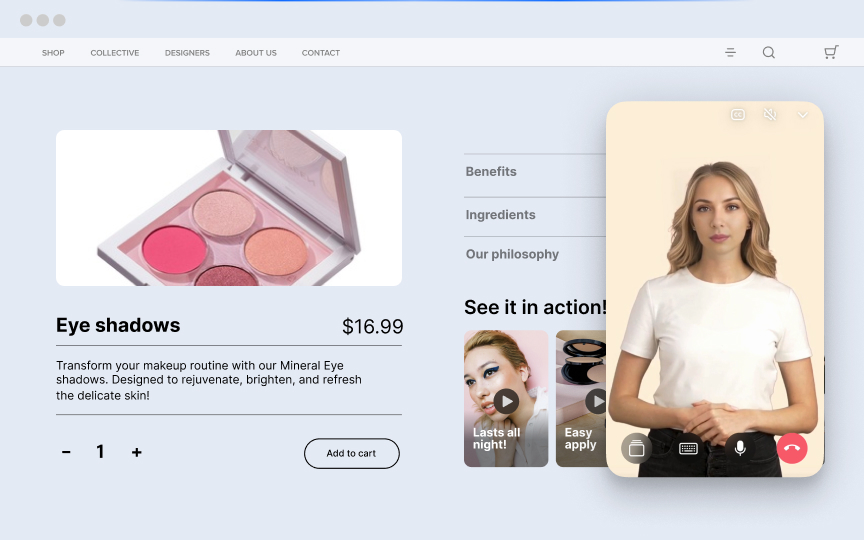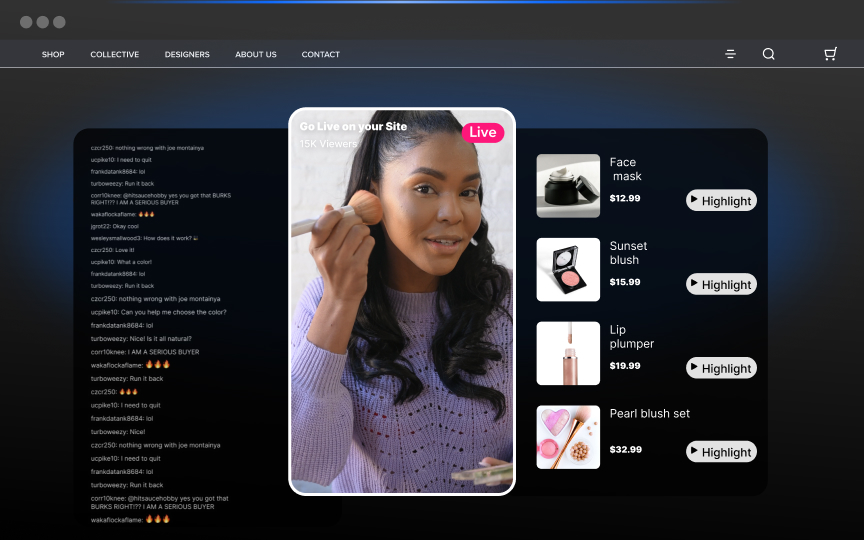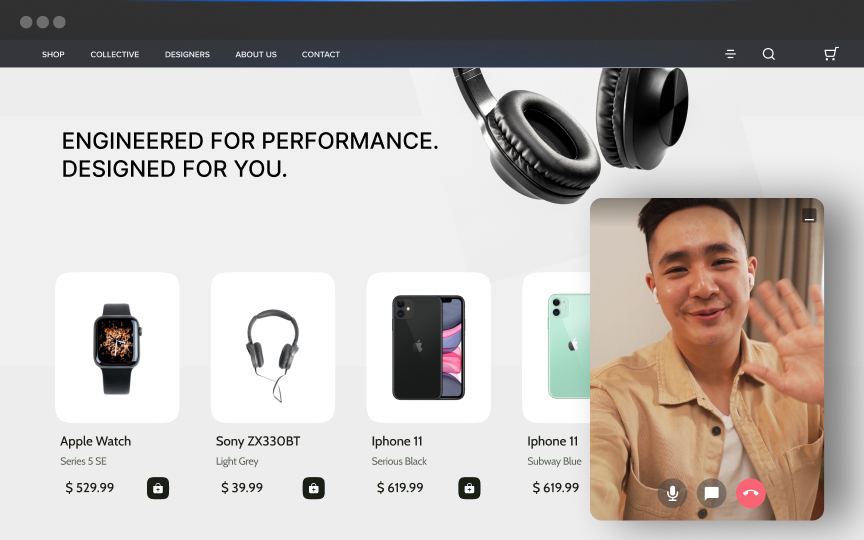How Video Shopping Lets Brands Use Content to Convert Customers
There has been an inevitable boom in the world of video shopping.
In fact, in 2022 more than 82% of all consumer internet traffic will come from online videos. This is 15 times higher than it was in 2017!
So, why is the video shopping phenomenon ruling customers and brands alike?Video commerce leverages video, a highly engaging format by default, to sell and promote products. As video shopping is very flexible, encompassing live shopping and shoppable videos, establishing a connection with the target audience becomes easier.Every brand and marketing team is rooting for an omnichannel strategy that creates a unified consumer experience. And videos are leading this race for omnipresence, with 86% of businesses already using videos as a marketing tool.Wistia found that the average time spent on pages with videos is more than on pages without them. In addition, the connectivity and interactions possible with videos are impossible with other content forms.
What Can Brands Do With Video Shopping?
Shopping videos are engaging, interactive, and open new avenues for brands. The scope to control and create content is vast. With a planned video commerce strategy, brands can…
1. Own Their Narrative
Top global brands, including L’Oréal, Burberry and Puma, are creating engagement with how-to-videos, Q&As, fashion shows and even product demos. Whenever brands create such videos, customers associate the content showcased with the brand’s identity.Consider the example of Purple Panchi, an Indian fashion brand. For better engagement and showcasing their product fits and designs, the brand has a dedicated section called ‘Purple Panchi TV’ on their web store.

The area has swipeable, shoppable videos where customers can see the product and directly make a purchase. This endless carousel of interactive eCommerce videos boosted average session lengths by 267%.When brands own their narrative, they also gain a competitive advantage. Most people still use social media and third-party channels for brand promotions, but well-planned interactive shoppable videos bring customers and data to your website, allowing you to plan and execute strategies tailored for your audiences.
2. Craft Content Specifically for Their Customers
The number of videos watched online has almost doubled since 2018.
According to eMarketer, brands noted a 16.45% conversion rate with videos, whereas standard banners and mobiles have a conversion rate of 2.14% and 1.62%, respectively.
Video shopping and the first-party data that comes with customer engagement allow brands to craft content their customers can enjoy. They can understand what content and interactions will get the conversions, and leverage it on their website and social media channels.For example, when Foo Tokyo started streaming informative videos on their homepage, they saw a 29.7% increase in page visits!
3. Create Shareable Content
Shareable content pieces increase brand awareness - even when the videos don't result in conversions right away, spreading the word about your brand will eventually lead to sales.The key to this is creating shareable content. Understand what audiences need and create videos that relate to them. Connect your product to their feelings and problems by appealing to their emotions. They will share them among their peer groups, broadening the audience for the content and, consequently, for your business.
4. Collect First-party Data via Engagement and Interactions
Are you using only social media and third-party channels to promote your products? If yes, here’s what you’re missing out on:
- Superior targeting analytics extending beyond demographics like age, gender, and geography
- Profiles that represent the ideal customer behavior
- Access to insights because of third-party and walled-garden policies
Video commerce has allowed brands to divert customers from social media to their websites. This enables brands to access the first-party data they would otherwise miss out on. Once brands get such data, they can build trust based on consumer behavior, improving accuracy and relevance.
Video shopping is helping brick-and-mortar retailers to create an online presence and generate more awareness. And it is helping small businesses create a phygital experience that attracts customers to their store.
Keys To Making A Video That Converts
You might understand the power of video shopping, but to be successful with conversions, you need to know what works. This includes content and the technical aspects. The former must create value for the customers, while the latter helps create this value to perfection. Let’s dive deep into some key factors to keep in mind while optimizing your videos for successful conversions:
1. Show, Don't Tell
You are mistaken if you associate this golden rule with writing only. The ‘show, don’t tell’ concept in video marketing is not just about not talking to the camera; it is about keeping the content descriptive and relatable. The formula is designed to answer a simple question - how do you want the customer to think, feel, and act after watching the video?You can follow this principle through relevant animations over voiceovers, product demonstrations, and screen recordings, or by using value-add testimonials.

Source: Burberry
Burberry has been practicing this for some time now, with their shoppable video content showing customers the look and other aspects of their bags. Customers also get details about the bag as well as the option to purchase it. This is a perfect example of show, don’t tell, and then sell!
2. Keep It Simple
Are you tempted by the thought of using elaborate effects, in-depth information, and additional razzmatazz in your video? Don’t do it. Overwhelming through video can cut down your viewers’ attention to a great extent. Instead, pay attention to the most straightforward implementation when delivering the goods.Always be careful not to overload your readers with too much information. Instead, give viewers just what they need to go on to the next phase of the buying process, which in video shopping terms could mean simply clicking on shoppable videos for instant information and purchase.
3. Make It Interactive
The first 30-seconds of a video (and 5-10 seconds for shorter videos) can decide its fate. Hence, grabbing the attention of the viewer within those first 30 seconds is critical.
Make the videos as interactive as possible. Live shopping events can easily leverage this with real-time interactions, like Q&As, with the customers.
Add CTAs and shopping buttons for shopping videos, integrate hotspots, and show 360-degree views for an immersive experience. For example, American Girl chose a live-shopping event for its ‘Girl of the Year’ announcement and roped in figure skater Tara Lipinski to generate customer engagement around the event. As a result, the livestream witnessed a 25% engagement rate!
4. Make The CTAs Clear And Obvious
Inform your audience of the actions you want them to take and the benefits they will receive. This entails creating a compelling value proposition for the following stages. To make a clear call to action, it is best to respond to the following question: How does moving forward add value for your viewer?You can enhance the video shopping experience by having clickable CTAs like ‘Shop Now’ or ‘Add to Cart.’
5. Go Vertical With Your Videos
A recent study suggested that people hold their phones vertically 94% of the time. This is a valid point to consider since turning a phone horizontally becomes an additional step in the viewing experience. We have already seen the introduction of vertical videos on mainstream platforms, including Instagram (Reels), YouTube (Shorts), and even Netflix. As people spend increasingly more time on their mobiles, they would also prefer watching videos in a vertical format.

Foo Tokyo saw a 556% increase in time spent on their website after launching ‘Foo Tokyo Stories’ - a carousel of informative vertical shopping videos.
6. Don’t Rush Customers Through It
The length of a video can make or break the video shopping experience. Keep it too short and you might miss out on delivering critical information in the rush to emulate short-form videos. Take your time to highlight the key features of your product to customers. Find innovative ways to highlight your products. For instance you can show a product’s features on the side of the video, while speaking about the product. Always avoid adding too many CTAs.For video commerce, the focus is always on the experience, and this can be done by storytelling, making your copy engaging and fun, and generating curiosity.
7. Distribute Across Channels And Platforms
Gone are the days when video’s only connection to shopping was paid ads on television. Nowadays, video shopping and commerce can be incorporated into a brand’s website. Such possibilities make the reach, access to data, and growth more organic. While creating videos for your brand, remember that optimizing them for multiple channels can help generate traction from all directions. While social media platforms are essential to consider while distributing your videos, always keep your website as the priority.
The Wrap Up
The video shopping wave has engulfed marketing and eCommerce strategies, and if any brand is not surfing it, they are missing out on reaching and engaging with the right audiences. Firework has been helping brands level up their video commerce capabilities with live shopping and shoppable video experience.Video shopping is not the future. It is here, now, and it is here to stay. The growth in the number of video shoppers and changing consumer behavior have made it imperative for brands to venture into the world of video shopping. Video commerce empowers brands to take control of their story and transform their growth into a more organic process. See some of the best examples here if you want inspiration to get started with video shopping.
FAQs
What is video shopping?
Video shopping is a method of shopping where consumers can browse and purchase products directly from a video. It allows brands to showcase their products in a more engaging and interactive way.
How does video shopping work?
Video shopping typically involves a live or pre-recorded video, often hosted by a brand ambassador or influencer. Viewers can interact with the host and ask questions about the products being featured, and can purchase products directly from the video using shoppable links.
How can brands get started with video shopping?
Brands can get started with video shopping by partnering with a platform that offers shoppable video capabilities, or by creating their own shoppable video content using video commerce solution providers like Firework.
Is video shopping the future of e-commerce?
Video shopping is an emerging trend in e-commerce, and many brands are finding success with it. While it may not replace traditional e-commerce channels entirely, it is likely to become an increasingly important part of the shopping experience for many consumers.
How can brands use video shopping to create content that converts customers?
Brands can use video shopping to create a variety of content that appeals to their target audience. For example, they can create product demos, tutorials, or behind-the-scenes content that showcases their brand story. By using storytelling and visual elements, brands can create an emotional connection with customers, increasing their likelihood of converting. Additionally, brands can leverage user-generated content, such as customer reviews and testimonials, to create authentic and relatable content that resonates with customers.









